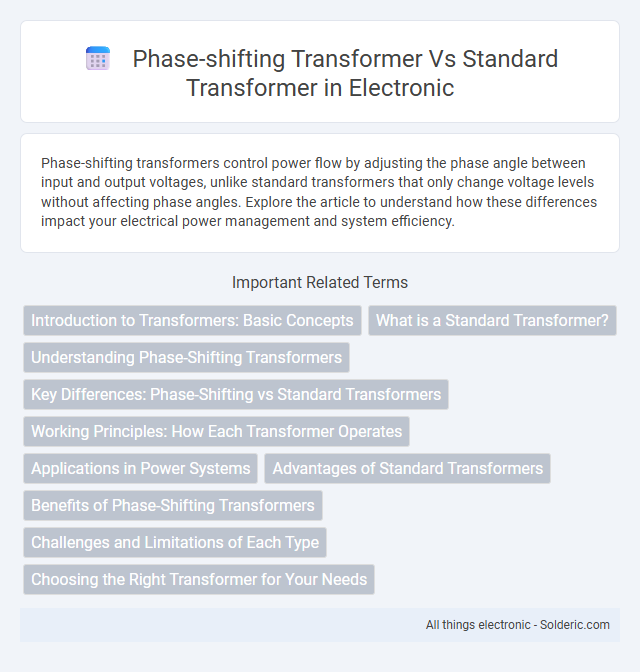Phase-shifting transformers control power flow by adjusting the phase angle between input and output voltages, unlike standard transformers that only change voltage levels without affecting phase angles. Explore the article to understand how these differences impact your electrical power management and system efficiency.
Comparison Table
| Feature | Phase-Shifting Transformer (PST) | Standard Transformer |
|---|---|---|
| Primary Function | Controls power flow by adjusting phase angle between input and output | Voltage transformation between different levels |
| Power Flow Control | Precise real power flow control in AC transmission systems | No direct power flow control capability |
| Applications | Power system load balancing, congestion management, stability improvement | General voltage conversion in power distribution and transmission |
| Complexity | High - includes phase-shifting winding and control mechanisms | Low - simple winding and core structure |
| Cost | Higher due to added components and control systems | Lower, standard manufacturing process |
| Operational Flexibility | Adjustable phase angle for dynamic power flow adjustments | Fixed voltage ratio, limited operational flexibility |
| Impact on Grid Stability | Enhances grid stability by controlling power direction and reducing congestion | No direct impact on grid stability |
Introduction to Transformers: Basic Concepts
Phase-shifting transformers (PSTs) and standard transformers both regulate voltage levels in electrical power systems but differ in functionality and application. Standard transformers primarily adjust voltage magnitude through electromagnetic induction without altering the phase angle between input and output. In contrast, phase-shifting transformers control the power flow by introducing a phase angle shift, enabling improved grid stability and load balancing in complex transmission networks.
What is a Standard Transformer?
A standard transformer is an electrical device that transfers electrical energy between two or more circuits through electromagnetic induction, primarily used to step up or step down voltage levels in power systems. It consists of primary and secondary windings wound around a magnetic core, enabling efficient voltage transformation without altering frequency. Standard transformers play a crucial role in power distribution by ensuring voltage regulation and system stability across transmission and distribution networks.
Understanding Phase-Shifting Transformers
Phase-shifting transformers (PSTs) regulate power flow by altering the phase angle between voltage waveforms, enabling precise control of active power in transmission networks. Unlike standard transformers that primarily change voltage levels, PSTs manage power direction and reduce system congestion by shifting phase angles, enhancing grid stability and efficiency. Their unique capability makes them essential in complex interconnected power systems to optimize load distribution and prevent loop flows.
Key Differences: Phase-Shifting vs Standard Transformers
Phase-shifting transformers regulate power flow by adjusting the phase angle between input and output voltages, while standard transformers primarily change voltage levels without altering phase angle. Phase-shifting transformers enhance grid stability and manage power flow in complex transmission systems, reducing congestion and losses. Your choice between these depends on whether voltage transformation or phase angle control is critical for your power network operations.
Working Principles: How Each Transformer Operates
Phase-shifting transformers regulate power flow by adjusting the phase angle between the input and output voltages, enabling control of active power direction in AC networks. Standard transformers operate on electromagnetic induction, transferring electrical energy between circuits through magnetic flux without altering the phase angle. This fundamental difference allows phase-shifting transformers to manage load distribution and prevent loop flows, while standard transformers primarily provide voltage level conversion.
Applications in Power Systems
Phase-shifting transformers enable precise control of power flow in transmission networks, reducing congestion and enhancing system stability compared to standard transformers. They are essential for managing load distribution and preventing loop flow in interconnected grids, optimizing the use of existing infrastructure. Your power system benefits from improved reliability and efficient energy transfer with the strategic deployment of phase-shifting transformers in complex network scenarios.
Advantages of Standard Transformers
Standard transformers offer high reliability and efficiency in voltage regulation across power systems, ensuring stable energy distribution. They are widely available, cost-effective, and simpler to maintain compared to phase-shifting transformers. Their robust design supports a broad range of voltages and power ratings suitable for general transmission and distribution needs.
Benefits of Phase-Shifting Transformers
Phase-shifting transformers (PSTs) enhance power system stability by controlling power flow and reducing loop currents, which standard transformers cannot achieve. Your grid benefits from improved load balancing, reduced transmission congestion, and enhanced fault isolation through PST deployment. These transformers enable precise phase angle adjustments, optimizing system efficiency and reliability compared to conventional transformers.
Challenges and Limitations of Each Type
Phase-shifting transformers face challenges such as higher complexity and cost due to their advanced control mechanisms, along with potential increased maintenance requirements compared to standard transformers. Standard transformers are limited by their inability to control power flow direction or phase angle, restricting their use in managing grid stability and congestion. Your choice depends on the specific need for power flow control versus straightforward voltage transformation, balancing cost and operational complexity.
Choosing the Right Transformer for Your Needs
Phase-shifting transformers provide precise control over power flow and are ideal for managing grid stability and reducing congestion in complex networks, unlike standard transformers which primarily focus on voltage transformation. Your choice depends on whether you need advanced grid control features or basic voltage regulation, with phase-shifting transformers offering better efficiency in load balancing and preventing loop flows. Evaluating your system's operational requirements and grid complexity will guide you in selecting the most suitable transformer for optimal performance.
phase-shifting transformer vs standard transformer Infographic

 solderic.com
solderic.com